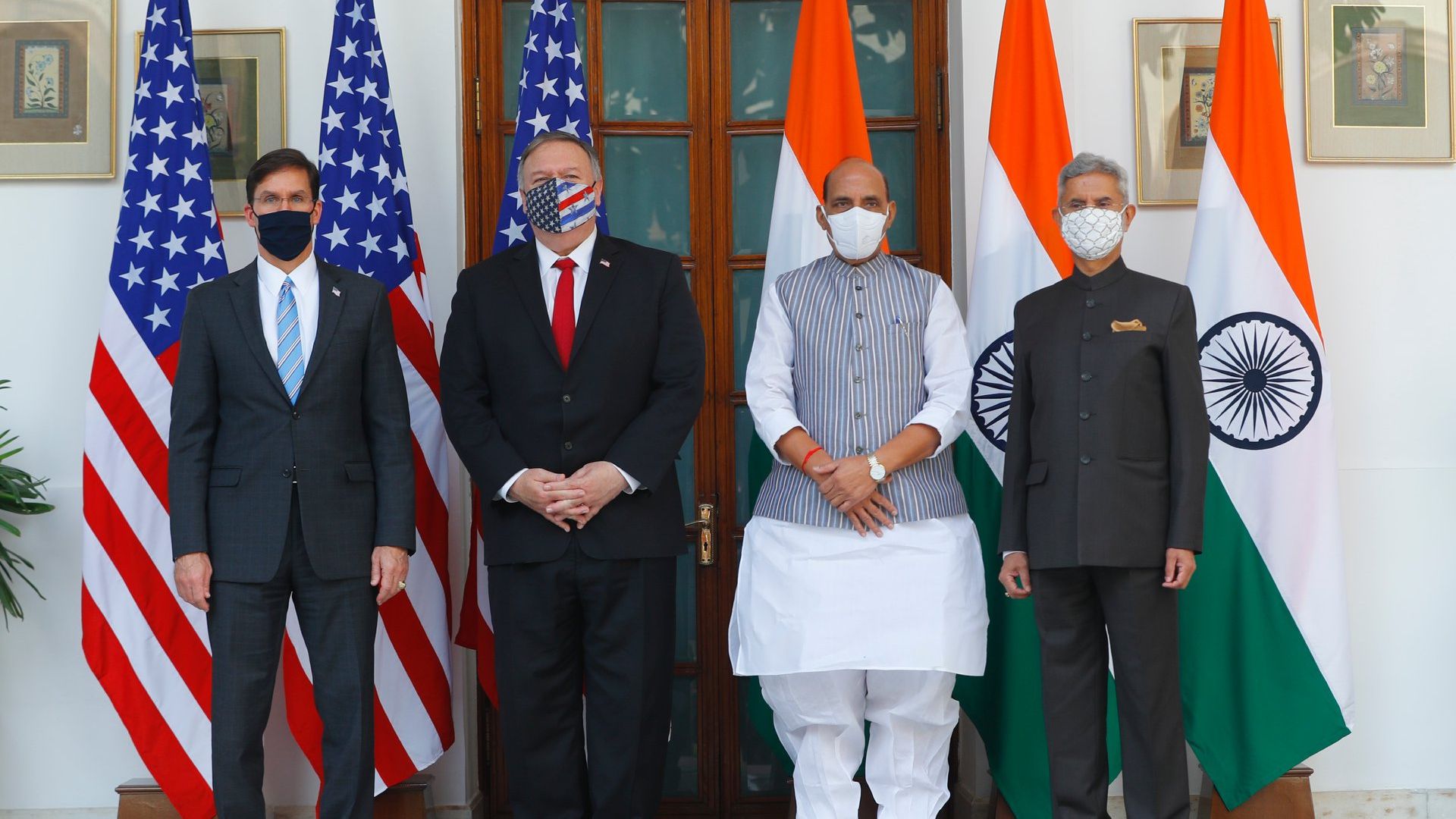At the third annual U.S.-India 2+2 Ministerial Dialogue, the United States and India discussed a collaborative path toward security and prosperity.
November 2020

U.S. Secretary of Defense Mark T. Esper (from left), U.S. Secretary of State Michael R. Pompeo, Minister of Defense Rajnath Singh and Minister of External Affairs S. Jaishankar ahead of their meeting as part of the 2+2 Ministerial Dialogue at Hyderabad House in New Delhi on October 27, 2020. (Adnan Abidi © AP Images)
From information technology and economics to health and defense, the futures of India and the United States are deeply interwoven—and this complex fabric was the focus of a recent high-level summit between the two powerful democratic nations.
In late October 2020, American officials traveled to New Delhi for two days of meetings with their Indian counterparts. U.S. Secretary of State Michael R. Pompeo and Secretary of Defense Mark T. Esper joined Indian Minister of Defense Rajnath Singh and Minister of External Affairs S. Jaishankar to discuss matters that focused heavily on intelligence, security and the military.
During the dialogue, India and the United States signed the Basic Exchange and Cooperation Agreement (BECA), a commitment that empowers both countries to more freely share key military intelligence and strategic information between their armed services. Alyssa Ayres, senior fellow for India, Pakistan and South Asia at the Council on Foreign Relations, which is headquartered in New York City, describes it as a foundational defense agreement that was under negotiation for years.
“Completion of this agreement now positions New Delhi and Washington, D.C., to further deepen defense interoperability,” she says, “a goal that has been pursued by successive U.S. administrations on a bipartisan basis.”
Aparna Pande, director of the Initiative on the Future of India and South Asia at the Washington, D.C.-based Hudson Institute, says that China was a significant focus of the dialogue, given its increasingly contentious relationship with both India and the United States.
“2+2 happened at a time when China’s rise, globally and regionally, is no longer peaceful and, instead, we are seeing China seeking to establish pre-eminence in the region and upend international order,” she continues. “There’s been a shift in U.S. policy where China is now seen as a rival. So, especially in this ministerial, American and Indian interests are coinciding not just philosophically, but in facing threats from China.”
The defense trade between India and the United States has grown to over $20 billion today, says Pande, and that will continue to expand. “India’s military needs modernization, for reasons including its continental and maritime conflict with China. The U.S. has provided military assistance and intelligence sharing with India and, with BECA, that will only continue and grow.”
With COVID-19 deeply affecting both India and the United States in countless ways, the pandemic played a key role in the discussions. Topics included development of treatments, mass production of vaccines and collaboration between the U.S. National Institute of Allergy and Infectious Diseases and the Indian Council of Medical Research via an International Center of Excellence in Research focused on infectious diseases including COVID-19 and other emerging threats.
“It was good to see the prominent place that health security cooperation on the pandemic occupied in the dialogue,” said Ayres. “Cooperation with India will be so important as the world looks to scale vaccines, once approved, and therapeutics. Global access to vaccines and therapeutics simply isn’t possible without India’s low-cost production capacity.”
While diplomacy, defense and the pandemic were key topics of the dialogue, the thriving economic bond between both nations was also discussed. “Trade between the U.S. and India is around $150 billion in goods and services annually, and both countries would want it closer to $500 billion,” says Pande. “With the U.S. and some of its allies seeking to decouple from China, there’s greater movement to the labor force in India, which would help both countries economically and strategically. This was discussed during the dialogue, but not in great detail.”
Ayres agrees that the focus on trade and economics was light, and that more progress will come in time, though advances in discussions of developing infrastructure like roads, bridges and ports hint at the countries’ shared priorities in the months to come. Ayres cites progress on the Blue Dot Network, an international initiative that supports and certifies the creation of resilient infrastructure, as a prime example.
Beyond any specific topic or agreement, Pande highlights the very symbolism of the ministerial dialogue. “The last four American presidents have consistently worked to build strong relationships with India,” she says. “This is the third 2+2 ministerial dialogue, and it’s happening one week before the American presidential election—yet nobody is citing the American relationship with India as something they don’t want. India retains what few have, which is a consensus of bipartisan support. That is very important.”
Michael Gallant is the founder and chief executive office of Gallant Music. He lives in New York City.
COMMENTS